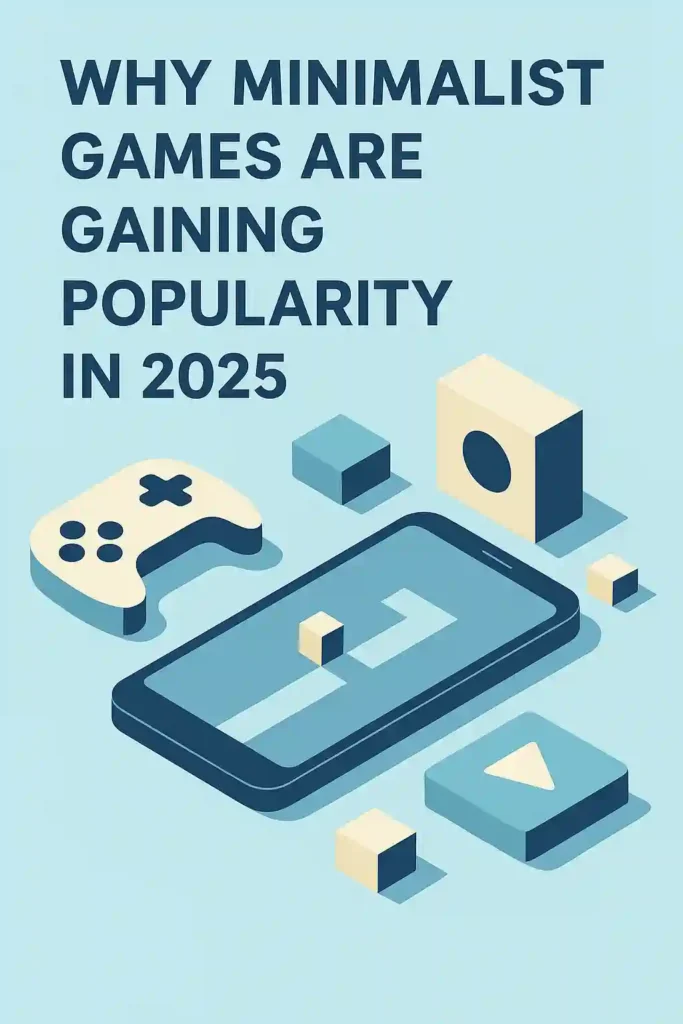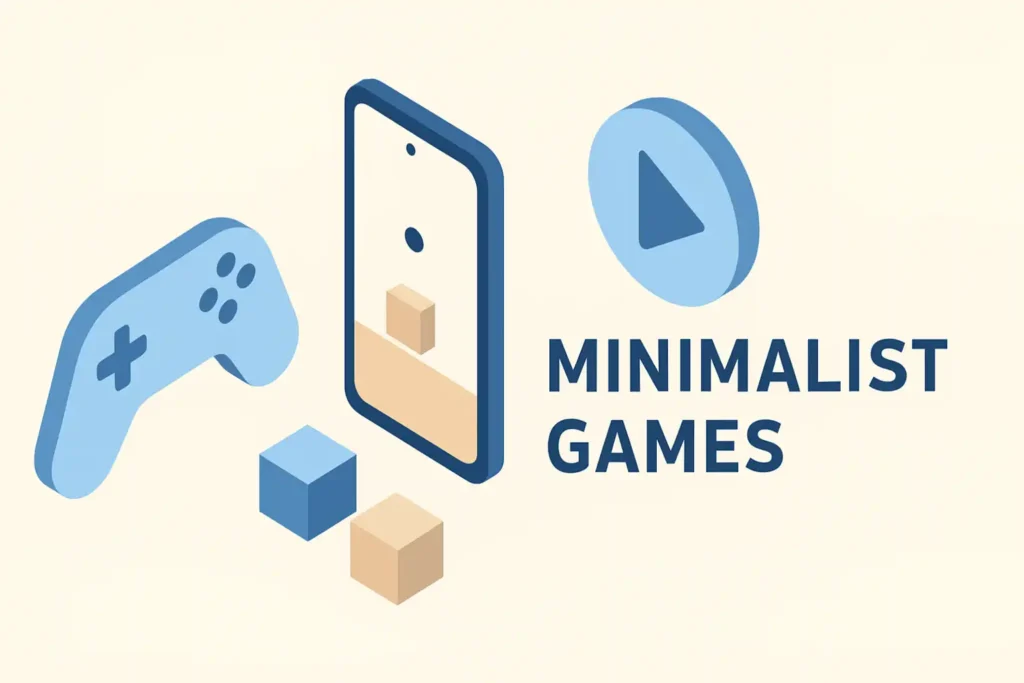Introduction
In the age of massive open-world adventures, cinematic storytelling, and hyper-realistic graphics, it might seem surprising that minimalist games—simple, clean, and often stripped-down experiences—are winning over more players than ever before in 2025.
Minimalist games don’t need flashy graphics, long tutorials, or hundreds of hours of gameplay to make an impact. Instead, they focus on clarity, simplicity, and pure fun. From indie studios to major developers experimenting with smaller titles, the rise of minimalist games reflects deeper shifts in how people want to play today.
So, why exactly are minimalist games gaining so much traction in 2025? Let’s break it down.

1. Simplicity in a Busy World
2. The Rise of Mobile and Browser Gaming
3. Focus on Gameplay, Not Graphics
4. Short Play Sessions Fit Modern Lifestyles
5. Mental Wellness and Calming Experiences
6. Indie Developers Driving the Trend
7. Nostalgia and Retro Appeal
8. Easy Sharing and Virality
9. Cross-Platform and Cloud Compatibility
10. A Counter to AAA Complexity

1. Simplicity in a Busy World
Life in 2025 is fast-paced. Between constant notifications, long workdays, and endless entertainment options, people crave simple, stress-free escapes. Minimalist games provide just that.
Instead of overwhelming players with massive tutorials and complicated mechanics, these games let you jump in instantly. A round might last just a few minutes, but that’s enough to feel refreshed.
Example: Games like tap2fly or classic snake let players relax with intuitive controls and calming visuals.
2. The Rise of Mobile and Browser Gaming
More than ever, people are gaming on-the-go—on phones, tablets, and directly in browsers. These platforms thrive on lightweight, minimalist games that load fast, run smoothly, and don’t eat up storage space.
In fact, one of the biggest drivers of minimalist game popularity is accessibility. A minimalist puzzle game can run just as well on a budget smartphone as it does on a gaming PC.
Example: The success of browser-based hits like Wordle proved that even the simplest mechanics can capture a global audience.
3. Focus on Gameplay, Not Graphics
For years, the gaming industry pushed for bigger, better, more realistic visuals. But in 2025, many players are realizing they don’t need photorealism to have fun.
Minimalist games strip away the noise and put gameplay at the center. They remind us that “the joy of gaming doesn’t come from flashy graphics—it comes from clever mechanics and satisfying challenges.”
Example: Thomas Was Alone turned simple rectangles into a powerful emotional story, proving graphics aren’t everything.
4. Short Play Sessions Fit Modern Lifestyles
Not everyone has time to sink 80 hours into an RPG. In 2025, people value games they can enjoy in short bursts—on a commute, during a break, or before bed.
Minimalist games are perfect for this. They deliver complete experiences in minutes, not hours. This makes them ideal for busy adults, students, or anyone juggling multiple responsibilities.
Example: Quick-hit puzzle games like Sudoku or Disk Tower offer satisfying gameplay in short sessions.
5. Mental Wellness and Calming Experiences
Minimalist games are often designed to be soothing and meditative. With clean visuals, gentle music, and simple mechanics, they can help reduce stress and encourage mindfulness.
As conversations about mental health continue to grow in 2025, more players are turning to minimalist games as a form of digital relaxation.
Example: Titles like Journey or Calm Waters are celebrated not just as games, but as calming experiences.
6. Indie Developers Driving the Trend
Minimalist games are easier (and cheaper) to build compared to big-budget titles. That makes them especially attractive for indie developers.
In fact, many of the most beloved minimalist games started as indie projects. Their smaller scale encourages creativity, experimentation, and unique ideas. Players in 2025 are hungry for fresh, original experiences—and indie developers are delivering.
Example: Celeste began as a minimalist indie project and became a global phenomenon.
7. Nostalgia and Retro Appeal
Minimalist design often reminds players of the early days of gaming, when games were defined by simplicity due to technical limits. Now, that retro-inspired simplicity feels fresh again.
Pixel-art, low-poly 3D, and clean geometric visuals have become a nostalgic yet modern style. For many players, minimalist games feel both new and comfortingly familiar.
Example: Games like Downwell or Super Hexagon combine retro-inspired graphics with modern mechanics.
8. Easy Sharing and Virality
Minimalist games often rely on simple mechanics that are easy to understand and explain. This makes them highly shareable on social media, where trends spread quickly.
Think about how Tap2Fly or Wordle exploded almost overnight. Their minimalism wasn’t a weakness—it was their superpower. Players could instantly show friends and family, fueling viral growth.
9. Cross-Platform and Cloud Compatibility
Cloud gaming and cross-platform technology have exploded in 2025. Minimalist games benefit from this because they don’t require huge downloads or heavy hardware.
Whether you’re streaming on a smart TV, playing on a phone, or hopping into a quick browser session, minimalist games are everywhere.
10. A Counter to AAA Complexity
While AAA studios still create massive, cinematic blockbusters, players sometimes feel overwhelmed by these experiences. Minimalist games act as the perfect counterbalance short, simple, and refreshing.
For many, minimalist games serve as a “palate cleanser” between longer, heavier games. They’re proof that less really can be more.
Challenges & Trade-Offs to Consider
Oversimplification: There’s a risk a game becomes boring or feels shallow if mechanics are too basic.
Monetization can be hard: With fewer features or in-game content, monetization needs creativity.
Market saturation: Many minimalist games are being made; standing out requires uniqueness.
Player expectations: Some players expect complexity or depth; minimalist games must deliver in subtle, refined ways.
Looking Ahead: The Future of Minimalist Games
Minimalist games aren’t just a passing trend—they’re shaping the future of gaming. With advancements in AI-generated design, procedural levels, and creative indie tools, we’re likely to see even more polished, innovative minimalist titles in the coming years.
In 2025 and beyond, these games will continue to stand out for their accessibility, emotional depth, and universal appeal. Whether it’s a five-minute puzzle or a meditative journey, minimalist games remind us that sometimes the simplest ideas are the most powerful.
FAQs
Q: What makes a game “minimalist”?
Minimal color palettes, simple shapes, little or no UI clutter, short interactions.
Q: Do minimalist games still make money?
Yes. Via ads, small purchases, premium versions, or cosmetic upgrades.
Q: Are minimalist games easier to build?
Often yes, but simplicity requires subtle skill—good design, polish, and idea originality are essential.
Q: Can minimalist design appeal beyond casual gamers?
Definitely. Many “core” gamers appreciate minimalist games for their clarity, challenge, or design purity.
Final Thoughts
Minimalist games are more than just “simple.” They’re a reflection of modern life fast, connected, and sometimes overwhelming. By offering players a clear, calming, and enjoyable escape, minimalist games are thriving in 2025.
From busy professionals to casual gamers, from indie studios to social media trends, the popularity of minimalist games is a sign that gaming doesn’t always have to be bigger. Sometimes, less is more.
External Links & References
Here are sources you can incorporate/link in your updated version:
Raph Koster / “A Theory of Fun for Game Design” (discussions about fun & simplicity)
Gamasutra-type articles / dev blogs analyzing minimalist style impact
Statista reports on casual / puzzle game usage trends
